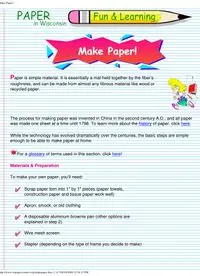
Make Paper 2008 PDF
Preview Make Paper 2008
Make Paper! Paper is simple material. It is essentially a mat held together by the fiber’s roughness, and can be made from almost any fibrous material like wood or recycled paper. The process for making paper was invented in China in the second century A.D., and all paper was made one sheet at a time until 1798. To learn more about the history of paper, click here. While the technology has evolved dramatically over the centuries, the basic steps are simple enough to be able to make paper at home. For a glossary of terms used in this section, click here! Materials & Preparation To make your own paper, you'll need: Scrap paper torn into 1" by 1" pieces (paper towels, construction paper and tissue paper work well) Apron, smock, or old clothing A disposable aluminum brownie pan (other options are explained in step 2) Wire mesh screen Stapler (depending on the type of frame you decide to make) http://www.wipapercouncil.org/makepaper.htm (1 of 5)9/10/2008 12:54:23 PM Make Paper! A 2½ gallon (or larger) tub that is larger than the wood frame or pan Dish towels (felt, blotting paper, couch paper, or newsprint are good substitutes) Blender Sponge Rolling Pin Household Iron Strainer Towels for cleaning up water Pieces of colored paper (optional) Pieces of colored thread (optional) Dried flowers or herbs (optional) Procedure The papermaking process is a wet one, so plan to use a work space that won’t be harmed by moisture. You might want to wear "wet gear" — an apron, smock, or old clothing. Remove any plastic, tape or coating from the scrap paper, and tear the paper into small (1") pieces. Soak the paper in warm water in the large tub for at least 30 minutes or, if you can, overnight. http://www.wipapercouncil.org/makepaper.htm (2 of 5)9/10/2008 12:54:23 PM Make Paper! Make a deckle frame: Aluminum Pan Cut a square hole in the bottom of the disposable aluminum brownie pan about 1" smaller than the pan’s outer dimension. Cut a piece of wire screen large enough to cover the hole when placed in the bottom of the pan. Other Options: Wooden Frame Buy or build a frame which you will prepare for paper making. If making a wooden frame, tightly staple or tack a wire screen to the frame. A plastic or wooden picture frame can make an excellent papermaking frame. Wire Clothes Hanger Bend the wire hanger to make any shape of your choice. Cover your hanger with a nylon stocking and staple it in place. Embroidery Hoop Place a screen or nylon stocking between two hoops to make another inexpensive frame. With adult supervision, fill the blender halfway with warm water, then add a handful of the soaked paper. Making sure the lid is on tight, blend at medium speed until you no longer see pieces of paper (the pulp has a soupy consistency called a slurry). You can blend in a piece of construction paper for color; or stir in short pieces of thread, dried flowers or herbs for texture. Pour the blended mixture into the large tub and then fill the tub with warm water, mixing thoroughly until the ingredients are evenly dispersed. Slide your frame into the tub, allowing some pulp to settle onto the screen and, still holding the frame underwater, gently move it back and forth to get an even layer of fibers on the screen. Lift the frame out of the mixture, keeping it flat. Allow it to drip over the tub until most of the water has drained through. You should have a uniform layer of the pulp mixture on the screen. Press the pulp gently with your hand to squeeze out excess moisture. Soak up excess water from the bottom of the screen with a sponge. http://www.wipapercouncil.org/makepaper.htm (3 of 5)9/10/2008 12:54:23 PM Make Paper! Couching: Place clean dishtowels, felt, couch paper or newspaper on a flat surface and flip the screen paper-side-down on the cloth. Lift the screen gently, leaving behind the paper. Cover the paper with another cloth or piece of felt, and squeeze out moisture using a rolling pin. Place the sheets out of the way to dry. You may want to let the paper dry overnight. When the paper is mostly dry, you may want to use an iron at a medium dry setting. When the paper is dry, pull the cloth gently from both ends, stretching it to loosen the paper from the cloth. Gently peel off the paper. When you’re finished making paper, collect the leftover pulp in a strainer and throw it out, or freeze it in a plastic bag for future use. Don’t pour the pulp down the drain. Use your paper to draw on, fold, or send to a friend! Glossary Couching: (pronounced cooching) Transferring the sheet of paper from the frame to the absorbent material. Deckle: A frame that holds the pulp in place and determines the size of the paper. Fibrous: Made of fibers; a fiber is one of the thin, (generally microscopic) strands which comprise plant tissue. Pulp: Fibrous material prepared from wood or recovered waste paper for use in manufacturing paper. Recycle: Reuse of a material. Slurry: A liquid mixture made up of fibers and fillers used in papermaking. Click here to return to the top of the page. http://www.wipapercouncil.org/makepaper.htm (4 of 5)9/10/2008 12:54:23 PM Make Paper! To explore more areas in Fun & Learning, click on a button below! Paper Facts | Latest News | History | Papermaking Process | Energy | Pollution Prevention Forestry | Fun & Learning | Links | About the Wisconsin Paper Council | Feedback Copyright © 1999 Wisconsin Paper Council http://www.wipapercouncil.org/makepaper.htm (5 of 5)9/10/2008 12:54:23 PM
